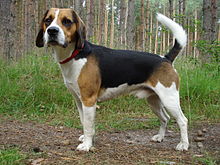Beagle-Harrier
| Beagle-Harrier | |||||||||||||||||
|---|---|---|---|---|---|---|---|---|---|---|---|---|---|---|---|---|---|
 Beagle-Harrier | |||||||||||||||||
| Origin | France | ||||||||||||||||
| |||||||||||||||||
| |||||||||||||||||
| Dog (domestic dog) | |||||||||||||||||
The Beagle-Harrier is a breed of dog originating from France. It is a scenthound, originally bred to hunt hares.
Characteristics
[edit]Appearance
[edit]
The Beagle-Harrier appears to be either a large Beagle or a small Harrier. It is a medium-sized dog, between 45 and 50 centimeters (18 and 20 inches) tall at the withers,[1] and it weighs between 19 and 21 kilograms (42 and 46 pounds).[2] Its coat is usually tricolor, featuring the colors fawn, black, tan, or white. There are also grey-coated (tricolor) Beagle-Harriers.[1] The Beagle-Harrier's body is usually muscular and its coat smooth and thick.[1]
Health
[edit]The Beagle Harrier is generally healthy and has a life span of 12 to 13 years. The breed can be prone to Hip dysplasia due to being a long-backed breed of dog.[3]
History
[edit]Beagle-Harriers were bred in France in the late 19th century by Baron Gerard, as a cross between the Beagle and the Harrier.[4][5] Like its parent breeds, the Beagle-Harrier was bred to hunt hares, and is now a pack hunter used for hares, deer, and other game.[5] The Beagle-Harrier was later imported into America in the mid-1800s to hunt rabbits.[6] It was recognized by the FCI in 1974.[citation needed] Especially outside of its native France, the breed is quite rare.[5]
See also
[edit]References
[edit]- ^ a b c FCI standards Archived February 7, 2007, at the Wayback Machine Retrieved 7 March 2007.
- ^ Continental Kennel Club Archived October 30, 2006, at the Wayback Machine Weight. Retrieved 7 March 2007.
- ^ Beagle Harrier Health Problems section. Retrieved 5 March 2007.
- ^ Wilcox, Bonnie (1989). Atlas of dog breeds of the world. Internet Archive. Neptune City, N.J. : T.F.H. Publications. ISBN 978-0-86622-899-2.
- ^ a b c Bruce Fogle (1995). The encyclopedia of the dog. Internet Archive. Dorling Kindersley. ISBN 978-0-7894-0149-6.
- ^ "Beagle-Harrier". 2puppies.com. Archived from the original on April 12, 2016. Retrieved 1 October 2016.
